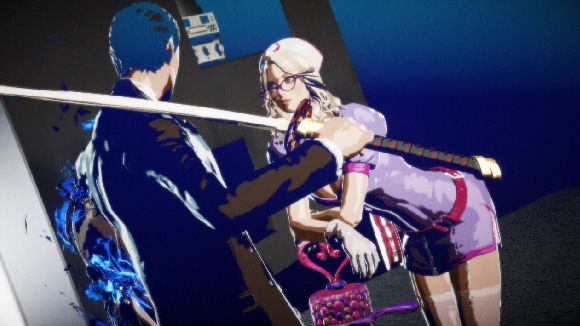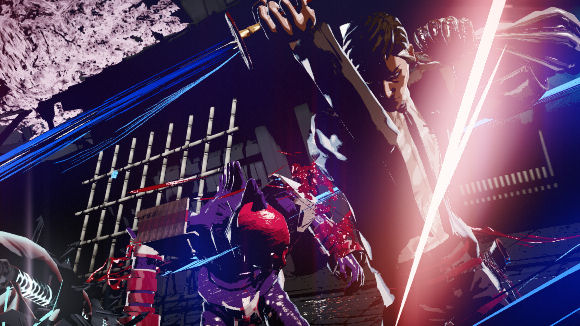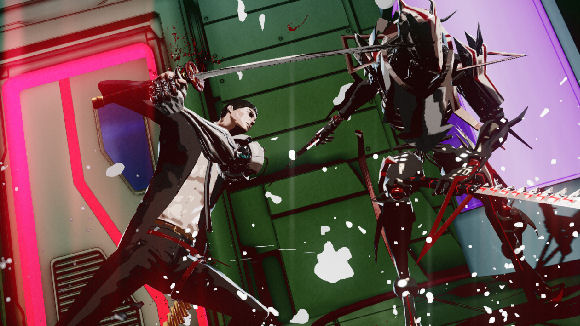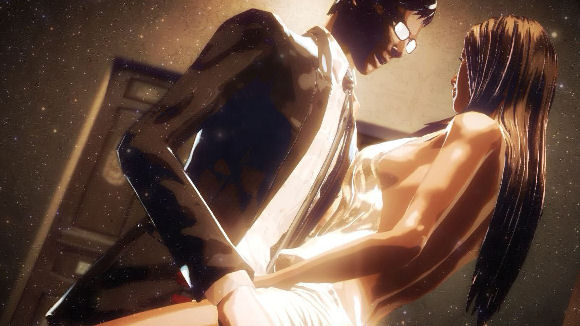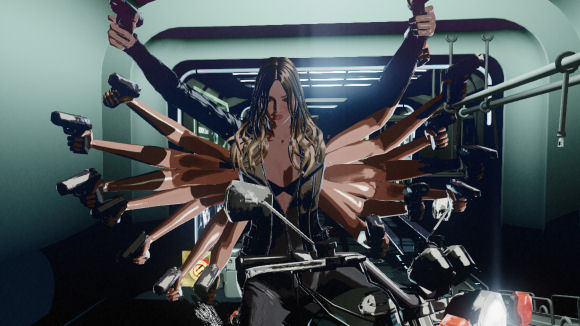Dressed to kill with a katana and a biomechanical arm, Killer Is Dead is an action-adventure game which puts you into the shiny shoes of Mondo Zappa, a dapper agent who works for Bryan’s Executioner Office, an agency which specializes in eliminating supernatural demons and “Wires”, bizarre humanoid ghouls from the moon. Oh yeah, and there’s the moon. Somehow the restless moon, a beautiful girl from its dark side and Mondo’s mysterious past are linked and through his adventures he and his crew will uncover their secrets.
The main part of Killer Is Dead is broken into 12 episodes, most of which begin with a terrorized client who requests the execution of some supernatural horror. To get to the target, Mondo must fight his way through armies of Wires using his “beloved katana” and his cyborg arm “Musselback”. Your adventures will take you to a wide variety of locations, like a runaway train barreling through Russia, a bizarre Alice in Wonderland house, and again, the moon.
In case you haven’t picked up on it, I’ll just get it out of the way here – The game is weird. You will spend a lot of time asking yourself why things are happening and most of those questions are never answered. The plot is thin and really serves as nothing more than a background to the action. KID uses cell-shaded character models to give it an anime look and like most anime the game is big on style and short on substance. But rather than being turned off by the latter, I found the game’s aesthetic and attitude to be pretty enjoyable. The rambling jazz tune that plays between missions and sleek title cards that introduce each episode were stylish and vaguely reminded me of serial anime like Cowboy Bebop. While KID’s setting and plot are shallow, it still comes off as pretty cool.
Most of KID is combat and mechanically the system is a relatively basic one – One button to attack, one to block and one to break through opponent’s defenses. Pressing the block button when an enemy is about to attack will perform a reversal which lets you knock down an opponent or deliver a devastating series of hyper fast sword swings. Mondo can also use his cyborg arm to shoot with several different gun types with various powers. As you progress you can improve and add to Mondo’s abilities with a small number of upgrades like new sword techniques or auto healing. Most of the combat involves fighting a wave of Wires with varying weapons, abilities and toughness before being able to move on to the next area. Levels are extremely linear, with only the occasional perfunctory puzzle-like task required to proceed.
Personally, I liked the relative simplicity of the system; I felt like there’s enough going on to keep battles interesting, but not so much crunch that it took a lot practice or brain power to be able to proceed through the game. But by the same measure, I doubt there’s enough depth to combat for real hack and slash enthusiasts. The game is a lot of button mashing, and the enemies you encounter are not especially varied. The boss fights are all cool designs and concepts but they are all mostly won with the same attack-block-counter pattern as the rest of the game. Players seeking complexity in this genre will likely find it too light for their tastes.
In between episodes you can perform side-missions. Most notably are the “Gigolo Missions”, a first-person mini game in which Mondo engages a pretty girl and has to steal glances at her breasts and, uh… lap without the target beauty catching you. The more Mondo ogles the girl the higher his Guts meter rises. When it’s full you can give the girl a present. Win over the girl’s heart with enough presents and you can take her back to your houseboat for a night of passion, and a maybe a new gun arm. For a game that’s not porn, it has some of the raciest simulated sex scenes I’ve ever seen from a Japanese game, including awkward Dragon Age-style banging with bra and panties on.
While the Gigolo Missions are over the top and silly, they are amusing for a bit. The remainder of the side-missions take place in previously completed levels and generally vary in their style – In one mission you have to protect a sexy girl from an onslaught of Wires using a turret gun. In another you and your busty boss ride a motorcycle through the streets of Kyoto trying to collide with enemies while avoiding obstacles. These side-missions are nice to break up the main episodes and while none of them are especially innovative they can be fun to mix up the action with. Unfortunately the only real reward to these missions is to collect additional experience and money to buy presents with. While novel, they don’t contribute to the rest of the game in any meaningful way.
Overall this game is okay at most of what it does. No one element is particularly well-executed, but if you’re willing to go along with its weirdness it is a sleekly done gaming experience, even if it is fairly shallow. The cell-shaded graphics are simple yet handsome, though they seem a little jagged for this day and age. Much to my surprise Akira Yamoka was in charge of the soundtrack and while he doesn’t amaze us like he has in previous works, there are some pretty good tracks that fit the anime styling.
One nice bonus is that the launch copy, which is apparently the only version available, retails for the standard price of a new game and comes with a lot of extras like a hardcover concept art book, soundtrack CD and DLC which adds an additional mission, skimpy costumes for your coworkers and a sexy vampire Gigolo Mission.
Despite the fact that I can’t find a lot of nice things to say about this game, I still feel pretty pleased with it. All the same, with the main mission completed I don’t feel any desire to pick up the game again and try to unlock any extras or replay any of the missions. Killer Is Dead is like a popcorn action flick; fun while it lasts but quickly forgotten. Completing the main story and most of the side missions took me about fourteen hours, which is just about the right length for a weekend rental, and is exactly how I recommend you enjoy this game.


